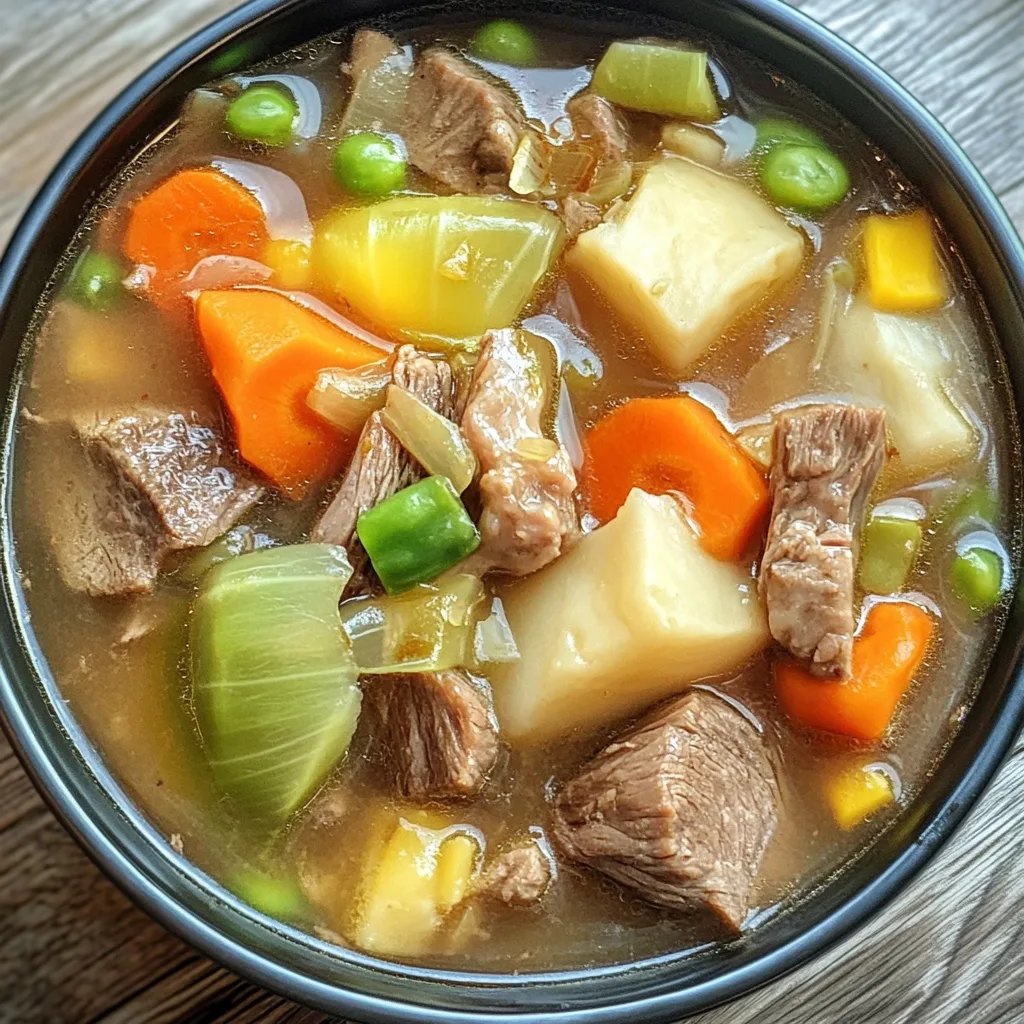Nilagang Baka: An Amazing Ultimate Filipino Beef Soup Recipe

Nilagang Baka is a comforting Filipino beef soup that features tender meat simmered with fresh vegetables. This incredible dish is not only delicious but also provides warmth and nourishment, especially during chilly days. It's a beloved classic in many Filipino households, often served during family gatherings and special occasions. The combination of beef, bone marrow, and a variety of vegetables creates a comforting bowl of goodness, packed with flavor and richness.
From the first savory sip of broth to the tender bites of meat and vegetables, Nilagang Baka captures the essence of home-cooked meals. It has the amazing ability to bring families together around the dining table while sparking conversations and memories. In this article, we will explore why this recipe is so cherished, how to prepare it, and tips for serving it perfectly. Whether you're a seasoned cook or new to Filipino cuisine, you'll soon understand why Nilagang Baka is a staple worth trying!
Why You’ll Love This Recipe
There are countless reasons why you’ll fall in love with Nilagang Baka. This recipe not only delivers a heartwarming dish but also offers an easy way to incorporate nutritious ingredients into your meals:
- Simple Ingredients – Most of the ingredients are pantry staples, making it accessible to many home cooks.
- Versatile Recipe – You can customize the vegetables based on availability or personal preferences.
- Nourishing and Healthy – The combination of beef and nutritious vegetables provides essential vitamins and minerals.
- Comforting Flavor – Each bowl of Nilagang Baka is like a warm hug, perfect for cold weather or feeling under the weather.
- Easy to Make – With clear step-by-step instructions, both novice and experienced cooks can prepare this dish without any fuss.
- Great for Sharing – It’s perfect for big gatherings, allowing everyone to enjoy a hearty serving straight from the pot.
The comforting smell of Nilagang Baka simmering on the stove is hard to resist. You’ll appreciate its incredible taste and the joy it brings to your dining experience!
Preparation and Cooking Time
Preparing and cooking Nilagang Baka typically takes about 2 to 2.5 hours, which includes simmering the beef to achieve that tender, melt-in-your-mouth texture. Here’s a breakdown of the time involved:
- Preparation Time: 20-30 minutes (to chop vegetables and prepare ingredients)
- Cooking Time: 1.5 to 2 hours (to simmer the beef and let the flavors meld)
- Resting Time: 5-10 minutes (before serving)
These times may vary based on experience and kitchen equipment, but they serve as a good estimate.
Ingredients
- 2 lbs beef shank or brisket (with bone)
- 1 onion, quartered
- 4 cloves garlic, crushed
- 1 large potato, peeled and cubed
- 2 cups corn (fresh or frozen)
- 2 cups cabbage, cut into wedges
- 1 cup green beans, trimmed
- 1-2 teaspoons salt (to taste)
- 1 teaspoon pepper (to taste)
- Water (enough to cover the beef)
- Optional: 2-3 stalks of celery, chopped
- Optional: 1-2 carrots, sliced
Step-by-Step Instructions
Creating Nilagang Baka is simple when you follow these easy steps:
- Prepare the Beef: Rinse the beef shank or brisket and cut it into large chunks if necessary.
- Boil the Beef: In a large pot, add the beef and enough water to completely cover it. Bring it to a boil over high heat.
- Skim the Foam: Once it boils, reduce the heat to medium. Skim off any foam that rises to the top for a clearer broth.
- Add Aromatics: Add the quartered onion and crushed garlic to the pot for flavor.
- Simmer: Cover the pot and let it simmer for about 1.5 to 2 hours or until the beef becomes tender.
- Add Vegetables: Once the beef is tender, add the potatoes, corn, green beans, and optional carrots and celery. Allow it to cook for another 15-20 minutes.
- Season: After the vegetables are tender, season the soup with salt and pepper to taste.
- Add Cabbage: Finally, add the cabbage and let it cook for an additional 5-10 minutes until just wilted.
- Finish: Turn off the heat and let the soup rest for a few minutes before serving.
These easy steps will lead you to a delicious bowl of Nilagang Baka that your family will love.
How to Serve
When it comes to serving Nilagang Baka, presentation and pairing can enhance the dining experience:
- Serve from the Pot: Traditionally, it is served straight from the pot, allowing guests to ladle their desired portions into bowls.
- Accompaniments: Rice is often served alongside the soup. You can also offer soy sauce or fish sauce on the side for those who prefer extra flavor.
- Toppings: Fresh herbs like chopped green onions or cilantro can be sprinkled on top for added freshness.
- Beverage Pairing: Consider pairing it with a light beverage, such as water, iced tea, or a mild beer, enhancing the flavors without overbearing tastes.
- Enjoy Hot: Make sure to serve the soup hot, as it is best enjoyed warm, which complements the flavors beautifully.
By putting thought into how you serve Nilagang Baka, you can create a memorable meal that celebrates the wonderful flavors of Filipino cuisine!
Additional Tips
- Use Fresh Ingredients: Always opt for fresh vegetables to enhance the flavor of your Nilagang Baka. Fresh herbs, especially, can make a difference.
- Adjust Seasoning Wisely: Taste the broth as it simmers. Adjust the salt and pepper towards the end of the cooking process to ensure you don't over-season.
- Serve with Lime or Lemon: A squeeze of lime or lemon just before serving can elevate the dish, adding a bright and zesty flavor.
- Enhance Flavor with Broth: For a richer broth, consider using beef stock instead of water or partially replace water with stock.
Recipe Variation
Explore these delightful variations of Nilagang Baka to suit your tastes:
- Spicy Version: Add slices of chili peppers to the pot for a spicy kick. Adjust the amount according to your preference.
- Herbed Edition: Incorporate herbs like dill or parsley for a fresh flavor twist. Just add them during the last few minutes of cooking.
- Using Different Cuts of Meat: Experiment with other beef cuts like short ribs or oxtail for varied textures and flavors.
- Vegetarian Version: Substitute beef with mushrooms and vegetable broth for a plant-based alternative, keeping the vegetables to maintain comfort.
Freezing and Storage
- Storage: Store any leftovers in an airtight container in the refrigerator. This will keep the soup fresh for up to 3-4 days.
- Freezing: You can freeze Nilagang Baka for up to 3 months. Make sure it is cooled completely before portioning it into freezer-safe containers. Always label and date the containers.
Special Equipment
While preparing Nilagang Baka does not require specialized kitchen gadgets, these tools will help you cook efficiently:
- Large Stock Pot: Ideal for boiling and simmering the beef along with the vegetables.
- Sharp Knife: A good knife makes chopping the vegetables easy and precise.
- Cutting Board: Having a sturdy cutting board can prevent slips and provide a stable surface while preparing ingredients.
- Ladle: For easy serving from the pot to individual bowls.
Frequently Asked Questions
Can I use frozen beef for this recipe?
Yes, you can use frozen beef, but ensure it is fully thawed before cooking for even tenderness.
What should I do if the broth is too oily?
The oil can be skimmed off the top after the soup has cooled slightly. You can also use a spoon to remove excess脂肪 before serving.
Can I use a slow cooker for Nilagang Baka?
Absolutely! Place all ingredients in a slow cooker and set it on low for 6-8 hours for tender results.
Is there a recommended side dish?
Steamed rice is the perfect complement to Nilagang Baka, as it soaks up the delicious broth.
How do I make it gluten-free?
Ensure all your ingredients, especially any sauces, are gluten-free. This dish is naturally gluten-free as it stands.
Conclusion
Nilagang Baka is more than just a dish; it is a sentimental part of Filipino culture and family gatherings. With its rich flavors, combined tenderness of the beef, and nutritious vegetables, this soup is a gateway to the heart of Filipino cuisine. Whether you're enjoying it with family or friends, each bowl serves not only food but memories, warmth, and comfort.
